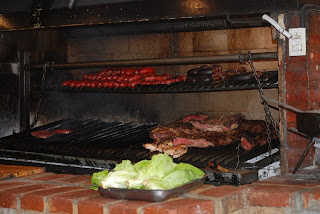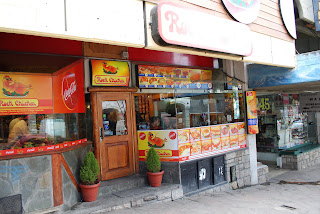



I have not been doing many tourist-like activities this week. Since I have moved downtown and on Wednesday we moved my classes into town, I have not been walking as far or visiting as many tourist locations. I did visit the Museum of Patagonia yesterday, which was very interesting. Sadly, the story of the Spanish encounters with and dealings with the Indians is the same as that of the US government. Once the railroads and refrigeration came, they could expand the cattle ranches in the pampas and so they needed to move the Indians out of the way. So they did. With violence. The pictures of the Indians in the museum from the late 1800's looked just like the pictures of the Indians in the US West from the same time period. Same faces, same clothes, basically the same people. I also visited the Cathedral, which I will say more about in another post.
So, I want to share more about the food. I did not tell you about parrillas and asado and postres. Parrillas and asado are the pride and joy of Argentina. Parrillas are "grills" and asado is "barbecue." They are often used interchangeably, although there are differences. Asado is often roasted meat cooked over an open wood fire on a spit, in fact lambs are cooked in a splayed-out fashion that is quite dramatic. Parilla is a form of grilling meat, similar to our grills, but always with wood or charcoal, never gas (as far as I can tell.) So, in essence they are the same thing, although Argentines will argue with you if you say that.
Parrilladas are basically steak houses, and also the term for a dish of grilled meat. At parilladas you can get steaks, although the cuts all seem to be different from the way we cut steak in the US. There are lomos, vacios, asados, bife de chorizo. (Lomo = loin; vacio is a sort of strip steak, asado a cut from the end of the ribs; and bife de chorizo, a large steak.) There are also other cuts, especially in the fancier restaurants. A parillada dish of grilled meat though usually includes more than just steak. It usually includes a variety of pieces of the cow or lamb, including: chinchulinos, a piece of roasted intestine; tripe, also intestine; higado, liver; corazon, heart; mollejas, sweetbreads (usually brains); and chorizo, which is similar to Italian sausage, and blood sausage, which does seem to be sausage that has actual blood in the casing along with other stuffing (it is very moist, even after cooking, and is very dark.) This is the national dish. I did have parrillada one day in Cordoba, and it was OK. I did not gag or get nauseous. The parts were all edible, but honestly, not my cup of tea. I would prefer a nice, juicy steak rather than all the innards, but I can say I tried it. I don't plan to try it again, unless Dianne wants to, and then I will since, actually, it is usually served as a dish for two or more people. (In Cordoba the owner of the Parilla was nice enough to split one for me.) The steaks are delicious. The beef is supposedly all grass fed on pampas grass, not in feed lots and not pumped full of chemicals. They pride themselves on the natural state of their beef. I have yet to encounter a tough or stringy steak.
As I mentioned, they do a lot with pasta, as well as chicken (almost everything they do with steak they do with chicken, and they also do more traditional chicken dishes) and they have pizzas galore. They have lots of wine available, the reds are the best, and in many places you can get cheap house wine by the glass or jar, which is not bad, and of course wherever you are ordering meat you can get bottles of wine, in a wide range of prices. They also serve water with or without gas and gaseosas (which are sodas).
For desserts they do flan, and rice pudding, plus tiramisu, and tortas (which are cakes, in a wide variety of styles, all very large portions and very rich looking.) They also have helado (ice-cream) which, because of the influence of their Italian immigrants, is basically the same as gelato! And, in Bariloche, they do chocolate! Wow, do they do chocolate. You cannot walk down a block on any street in the downtown without encountering a chocolate store. Some of the larger stores have two or three locations (smaller satellite locations in addition to the main store). I taste tested my way through many of the stores searching for the best to buy for family back home and definitely Mamuschka is THE BEST! They have bonbons filled with liquor that is like getting an actual shot of whisky once you bite into it! Not just a taste. And their tablets of dark chocolate are divine. The second-best I found is a small shop on the other main street, "Chocolate de Pueblo" and the third best was a small shop where you could see them making the chocolate out my the school, but I have not returned there, so I only tried it once. There is even a chocolate museum in town, operated by Fenoglio, one of the large chocolate stores, but I did not visit. I have definitely been following the new physician guidelines for preventing strokes by consuming a small (I stress small) quantity of dark chocolate each day while I am here. (I have also lost weight, so I promise you it has been a small quantity. Besides, the chocolate is so rich that you really do not need, nor can I, consume a large amount.)
I am including a link to a Kodak Gallery album with pictures of Bariloche town that give you a feel for the city itself, aside from the spectacular views of the mountains and lake. The pictures above are of two parillas, the one in Bariloche of which I spoke, and the small one in Buenos Aires, with examples of the meat on the grill. Follow this link to the pictures of Bariloche: http://www.kodakgallery.com/I.jsp?c=6d2p4u6.2m4f8m3a&x=0&y=8z6e2g&localeid=en_US
No comments:
Post a Comment